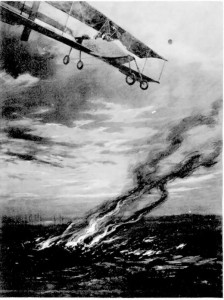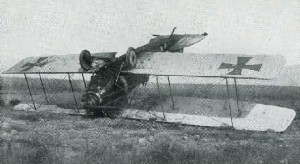During World War One, the role of airplanes and how they were used changed greatly. At first planes were only used for sport, but people started realize that not only could airplanes be useful but they could even influence an outcome of the war greatly. Soon the war was filled with blimps, planes, and tethered balloons.
By the end of the war, planes became a symbol of fear, but they were not always treated with such respect. In the time leading up to the war, the general feeling about planes was, they were a sneaky, unfair tactic that should not be used in warfare. During The 1899 Hague Peace Conference, it was put on record that the dropping or shooting of any projectiles or explosives from the air during a time of war was forbidden and was considered a crime of war.
It was also decided that airplanes could only be used for reconnaissance or spying missions. (Villard-227) “The airplane may be all very well for sport, but for the army it is useless” (Quoted in Villard-227) Even by the beginning of the war in 1912, the use of planes in the war was still prohibited by the War Office.
Shortly thereafter this changed, people awakened to the possibilities of air warfare. The world soon started to realize the effectiveness of planes in war and how the control of the skies could influence the outcome. Although the French were the first to have a working, conscripting air force and to license fliers, their trust in airplanes still was not up to par. Their lack of trust was justified, for the planes had no armaments, too many wires, and no reliable motor. (Villard-228)
Soon all countries in the war effort had their own little air force, built hangers, and started to train pilots. The first bombing occurred in November 1911. Although the first bomb was dropped by the Italians, soon all countries were involved in bombing raids. (Villard-229) It was followed by the first aerial dogfight in 1912. This consisted of a primitive exchange of pistol fire between British and German planes. (Harvey-95)
The first flying experience for the United States occurred in 1862, during the Civil War. General McClellan went into battle against the South with a balloon corps floated by hydrogen and pulled by four horses. (Saga-51) Literary fiction started to breed ideas about the use of planes in warfare. The most famous writer to explore the idea was H.G. Wells.
He wrote The War In The Air, a book about the future in which battle is conducted with planes. (Wohl-70). In Germany, literary fiction preceded the actual development of warfare in the air. Rudolph Martin was a writer who predicted that the German’s future was not on the sea, but in the air.
He also believed that further development in aviation would kill the importance of distance and help to lead toward the German unification of the world. (Wohl-81) Martin’s novel helped to prepare the Germans for their use of planes in the war. The fiction soon became scientific fact. (Wohl-71) The United States, ultimately was slower than France and Germany to develop an air force.
On March 3, 1911, Congress appropriated $125,000 to start an air force, which consisted of five planes. The first squadron was organized by the Americans on March 5, 1913, in Texas City. It consisted of nine planes. Although the United States entered the war in 1917, it did not use planes in the war at that time. (Villard-231) U.S. pilots had little or no experience in “cross-country navigation.” They did not have good maps and sometimes they became lost, ran out of fuel and would have to land behind enemy lines. (Villard-233)
As the Americans advanced in the use of planes in warfare, so did the Germans. Initially, the Germans made no effort to hide their skepticism about the use of planes in warfare. In the beginning of the war, many Germans raised in newspaper articles and on government committees the possibilities of warfare in the air, but the country as a whole was not quick to initiate the effort. (Wohl-70)
This quickly changed, however, because the development of airplanes during the war was mostly credited to the Germans. The Germans came out with advances in planes that outdid anything that France had to offer.
Even though France had the largest air force in the world, they soon became second-best. No matter how hard the other countries tried, the Germans were always one step ahead in airplane advances. These advances were so great that even though the Germans were outnumbered eight to one, they still came out on top.
For instance, the mounting of a machine gun behind the propellers seemed like suicide, but the Germans came up with the idea of a timed switch that would allow the gun to fire in-between rotations. This made it easier to aim and fly at the same time. Roland Garros, an allied flier, who mounted a gun in the cockpit and put protective plates on his propellers was trying to match the German timed device, but it was a faulty, unsafe rip-off. (Harvey-95)
Another advancement used by the Germans was the introduction of luminous paint so that pilots would not fly into each other or shoot each other during night raids. (Duke-130) The allied countries tried many times to duplicate this and many other German inventions but failed each time. The Germans started putting up hangers and domes around its borders. They introduced more and more types of planes.
As the war went on, Germany introduced the BI-planes and Tri-planes which made the use of one-winged planes obsolete. The more wings, the more mobility, stability, and speed the plane had. The mobility made it easier to evade gunfire or to maneuver better in dogfights. The stability made these new planes handle better in turbulence, and in reconnaissance missions, the speed was most important for escaping the enemy.
These new German planes dominated the skies and made lumber of the allies’ “flaming coffins” (old mono-planes) The BI-plane was considered to be the best all-around plane. It was the favorite of the German Flying Ace, Manfred von Richthofen, and better known as the “Red Baron” The Red Baron was the best pilot in the war and was credited with shooting down 80 allied planes.
He was equally respected by both sides, and when he was shot down, his enemies held a service for him to show how much respect they had. This show of chivalry was not uncommon, for at the beginning of the war, it was tradition to throw down a wreath if an enemy plane was shot down, to show respect and honor.
However, when the bombing was introduced, the feeling about planes turned from noble flying knights into fear, death from above. The evolution of aircraft during World War One was profound and unmatched by any other advancement in any other field at the time.
From Reconnaissance to bombing, the use of airplanes in the war became a necessity and by the end of the war airplanes and pilots had earned the respect they deserved. Today’s warfare relies heavily on the use of aircraft, not only for destruction and transportation of troops and supplies but also for its initial use of reconnaissance.


